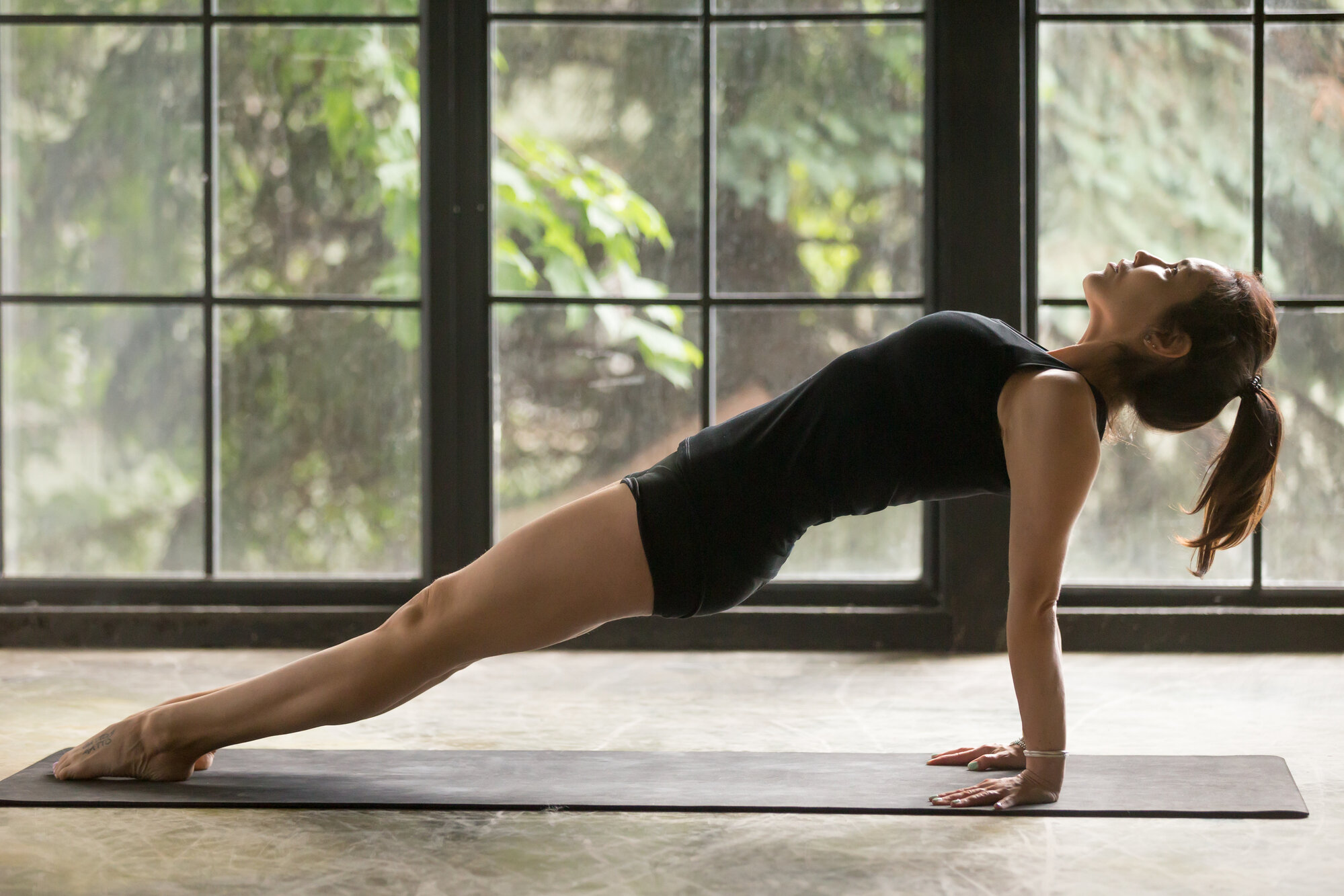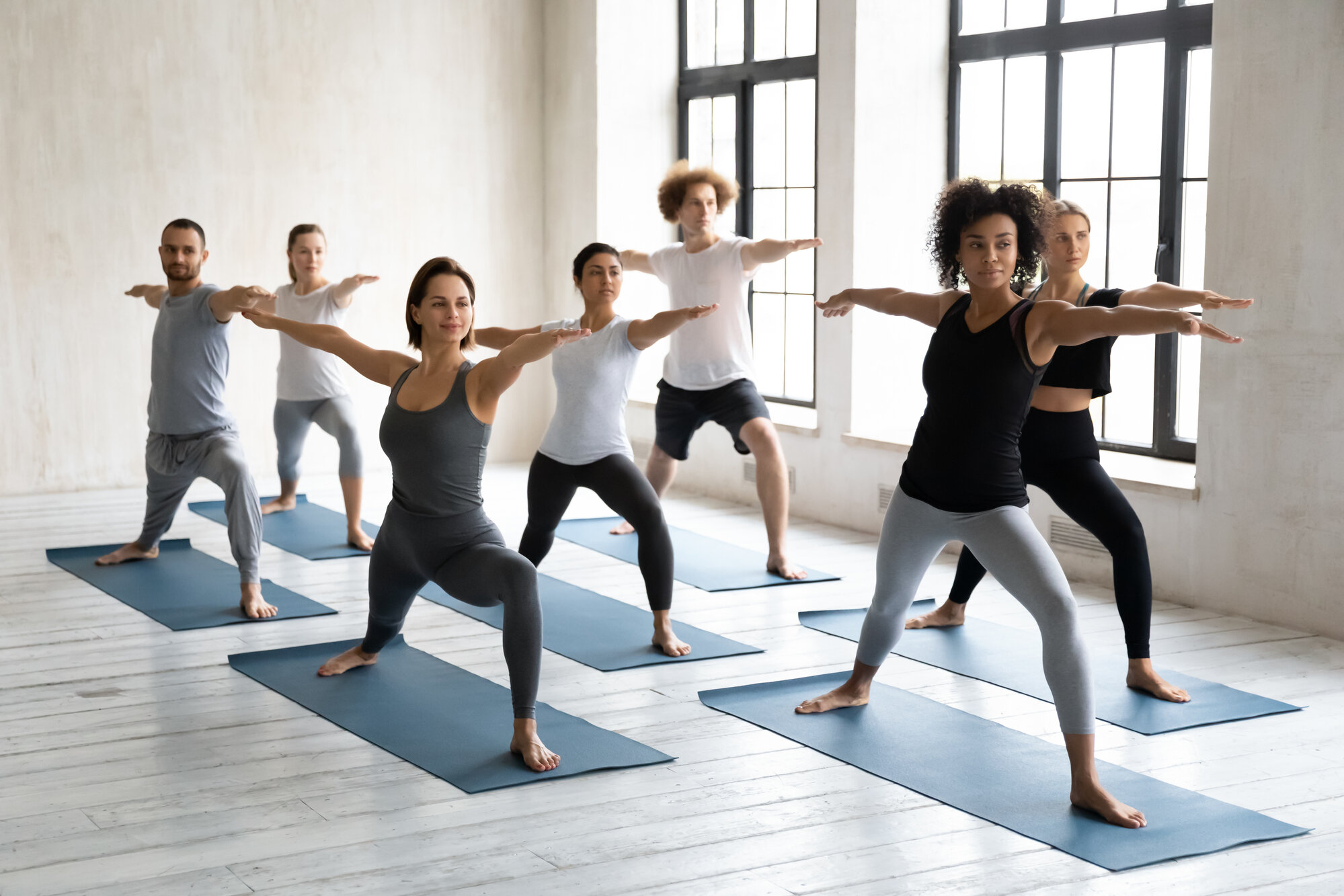Is Yoga Enough to Be Your Only Form of Exercise?
This blog post was first sent to Jenni’s email list as an email newsletter. Sign up for the JRY email newsletter here!
By Guest Contributor Carolin Polter
Introduction from Jenni:
I am more than excited to present a fantastic and educational special guest article today that examines the question, “Is yoga a complete practice?” from a research-based lens. Berlin-based yoga teacher Carolin Polter is someone whose work I admire greatly, and I was thrilled when she agreed to explore this question for my blog!
I think Carolin has done a masterful job of using science in a digestible, relatable way to outline a clear picture for our yoga community. Where does yoga excel in terms of its physical benefits? And what movement ingredients might yoga be missing? How might we address these missing ingredients both within our yoga practice and outside of it?
I hope you enjoy Carolin’s engaging and informative article. Please let us know what you think of the piece if you have a moment!
—Jenni
Is Yoga Enough?
by Carolin Polter
Note: When talking about “yoga” in this article, I am referring to the modern forms of postural yoga as they are currently taught in the West. Furthermore – despite being aware of yoga’s spiritual, mental, and emotional implications – I’ll be focusing on the physical components (the postures/asana) exclusively to discuss their effectiveness as a movement practice.
Is yoga enough to be your only form of physical exercise?
When I first started my yoga practice and for many years after, I was convinced that I had found the Holy Grail of movement. Coming from a not-so-active background, I felt my whole body toning up and getting stronger. I fell in love – and as love has it, idealized the hell out of it. As I became a yoga teacher myself and continually deepened my studies and understanding of the human body, the pink vapor slowly began to dissolve and I started to realize that – despite its many benefits – there actually are a few itches a yoga practice can’t scratch.
What Would a Perfect Movement Practice Look Like?
Before we can talk about yoga’s potential deficits, we need something to measure it against. The American College of Sports Medicine’s (ACSM)[1] most recent Position Stand (published in 2011) serves as a good benchmark. According to the ACSM’s definition, physical fitness is the sum of “cardiorespiratory fitness, muscular strength and endurance, body composition and flexibility, balance, agility, reaction time and power”[2]. To improve physical fitness and health, the ACSM provides evidence-based recommendations, dividing exercise into four categories:
1. Cardiorespiratory (“aerobic”) exercise
“Aerobic exercise improves the capacity of the cardiovascular system to uptake and transport oxygen[…] [and is] considered the cornerstone of endurance training.”[3]
2. Resistance exercise
Also known as strength training, it basically means that your muscles are contracting (“working”) to withstand an outer resistance. This can be external weights but also the weight of your own body.
3. Flexibility exercise
Flexibility is the ability to move all of your joints through their complete ranges of motion (ROM), which can be achieved through different kinds of stretching.
4. Neuromotor exercise training
Involves training motor skills like balance, agility, coordination, and gait as well as proprioception.
Looking at these categories, your little yoga heart might just be beating a bit faster. Cause it is true – yoga checks many boxes!
What Yoga Can Do
The ACSM paper states it itself: “Multifaceted physical activities such as […] yoga involve varying combinations of neuromotor exercise, resistance exercise, and flexibility exercise.” You may already notice that cardiorespiratory exercise (from now on called “cardio”) wasn’t listed, but we’ll get to that in a bit.
Yoga in research is still in its beginnings (unless you’re talking about its relation to stress relief), but you probably don’t need the backup of a million studies to realize that it
Increases strength and mobility (ROM) in various muscle groups (especially when coming from a rather sedentary lifestyle),
Increases your balance through countless Tree and Warrior III poses
Helps your general sense of proprioception (aka body awareness) by guiding your focus into different body parts and what they’re doing as you move.
This manifoldness can easily cloud one’s vision to the fact that the perfect one-serves-all exercise form has yet to be discovered.
What May Yoga Be Missing?
1. Cardio/Endurance Training
Lay people know they’re doing cardio when their heart is thumping and they’re huffing and puffing like a steam train. It’s a whole sweaty mess. And I know, some of you may now interject: “Hey, my practice has me huffing and puffing, too!“ Fair enough. Let’s try to look at it from a scientific point of view, though.
The ACSM recommends moderate and/or vigorous cardio exercise for most adults. One common indicator to determine intensity is %HRmax (the percentage of one’s maximum heart rate reached during an exercise). Moderate cardio exercise is commonly referred to as 64–76% HRmax, while vigorous exercise lies between 77–95% HRmax.[4] In “deconditioned” people, a light (50–63% HRmax) to moderate intensity may be beneficial, too. However (and this is important!), a gradual progression is recommended to maintain the positive effects of the practice as the body adapts.
What intensity does yoga provide? Studies that measured heart rate in yoga presented results ranging from as low as 42% HRmax (gentle yoga, very light intensity) to as high as 80% (Surya Namaskar, vigorous). Differences in study designs make it difficult to come up with one conclusive answer, though more active styles like Vinyasa, Power Yoga, or Ashtanga Vinyasa seem to produce higher results than Hatha or gentle yoga practices.
Tsopanidou et al. (2018) measured the heart rate of 24 adults with a regular yoga practice during a 90-minute Vinyasa Yoga class and found that “for at least 60 min (main part) during a Vinyasa yoga session, the participants used 69% to 72% of their % HRmax”[5]. The median HRmax for the whole duration of 90 minutes came to 63 ± 5%, making it a cardio exercise of low to moderate intensity. The highest levels have been reached during Sun Salutations at 72 ± 7% HRmax.
Ward et al. (2013) measured 38 participants with prior yoga experience during 50-minute Vinyasa classes and found that the heart rate of most participants corresponded to very light (<50% HRmax, n=6) or light intensity exercise (n=21), while 10 people were in the moderate range and one person was in the high intensity range.[6]
The situation is highly subjective and depends on who you’re talking about. Yoga actually may count as cardio exercise in people with low to moderate fitness levels (like sedentary me back then). However, since the human body constantly adapts to the demands put on it, all of us are sooner or later going to reach a point where even the sweatiest Vinyasa class doesn’t suffice to have us leave that very light to light intensity range anymore. So if you’re noticing that you’re becoming increasingly happy about how easy yoga classes have become, it may be the time to look for movement forms that get you huffing and puffing again to complement your routine (e.g. running, cycling, swimming, high-intensity interval training (HIIT)).
2. Pulling Strength
This is actually the most obvious “deficit” of a yoga practice, yet as yogis we often seem to forget that there is even such a thing as pulling. All we do is push. Be it in plank, Chaturanga, forearm stand, handstand, downward facing dog – we’re cued to “push the ground away“ or “really push into” our mats. These poses strengthen muscles that are mostly on the front side of our upper body: the chest, shoulders, and triceps. What we don’t do (simply because it’s difficult to integrate on our mats) is pull things towards us or pull ourselves towards things. Pulling exercises strengthen muscles that are mostly on the back side of our upper body: the lats, traps, rhomboids, posterior delts, and biceps.
If yoga has been your only form of upper body exercise for the past few years, and you’re proudly showing off your strong Chaturanga arms (been there, done that) try hanging from a bar and attempt to pull yourself up. It’s like reality is laughing in your face. The ACSM recommends regular strength training for ALL major muscle groups. Bodies really like to be strong as a whole. So pulling strength may be something you want to explore into if yoga has been your only form of exercise.
Below are a few examples of ways to incorporate pulling strength into your movement practice. Off the mat, rock climbing and bouldering also make for a good complement to yoga.
3. Progressive Overload
We already established that a yoga practice can serve as strength training. I am now going to add this: up to a certain point. When talking about strength, it is important to note the interconnectedness of our bodies’ tissues. We can’t just talk about muscles like they exist in a bubble. Muscle fibers actually become tendon fibers as they connect to bone. The strength of your right leg depends as much on your muscles as it does on tendons, ligaments, and bone.
To explain yoga’s potential limitations in terms of strength training, we have to make a detour into biomechanics and meet Julius Wolff. Wolff was a German anatomist who, in the 19th century, postulated Wolff’s Law, which says that all (non-pathological) bones adapt to the loads put on them. Drawn from that was Davis’ Law, stating that the same is true for the connective tissues surrounding bones. They get what we would call “stronger.” Simultaneously, “underloading” bones and tissues has the reverse effect, making them “weaker.” Therefore, to maintain our bodies’ strength, we need to constantly progress the “stress” we put on it. This is in line with the ACSM’s recommendation for “a gradual progression of greater resistance.”
These concepts are widely mirrored by research. A systematic review by Kistler-Fischbacher et al. (2020) reads: “[L]ow intensity exercise was not an effective stimulus to increase bone mass. Higher quality evidence suggests moderate to high intensity interventions […] were most beneficial for bone mass.”[7] A systematic literature review by Walther and Herold (2007) came to a similar conclusion: “There is level I evidence, that sports with high maximal force can reduce the natural loss of BMD [Bone Mass Density] over time.”[8]
In regards to connective tissue, Arampatzis et al. (2007) investigated the effect of different loads on the Achilles tendon. They found that a low strain on the Achilles tendon was “not a sufficient stimulus for triggering further adaptation effects”[9], whereas positive effects were found under high strain training.
There are various ways to increase load in a yoga practice. While this could be the topic of another entire article, here are a few ideas:
Change your position (arms forward in Warrior III instead of arms back or wrists in front of the shoulders instead of underneath in plank)
Decrease the points of contact with the floor (Warrior II with the front heel lifted or 3-legged plank)
Incorporate props like resistance bands or weights
In your standard yoga class setting, though, options will most likely be limited to what you can do with your own body weight, which may not suffice for all eternity. It’s the same as with cardio: if poses become easy, it may be a good idea to up the load, to support that continuous urge for your tissues to adapt – even if it means looking for alternative training options.
4. Variability
This last point actually doesn’t have to be one of yoga’s issues, but very much depends on what your yoga practice looks like. Do you follow a set sequence, as it’s commonly done in Ashtanga yoga, for example? Or do you practice a free flow Vinyasa style but always adhere to a certain kind of alignment (e.g. knee stacked over the ankle in Warrior II)? In that case, you’re somewhat limiting your body’s potential (if that type of yoga were your only movement practice).
Unfortunately, common alignment beliefs in the yoga world often get in the way of movement variability. Let’s come back to the cue of keeping the knee right atop the ankle in Warrior II to “protect” said joint. I’m sure you’ve heard this at least once in a yoga class, right? “Stacked joints are the best joints” seems to be a common misbelief amongst yogi*nis, and this is actually often taught in Yoga Teacher Trainings, as well. What happens, though, when you leave your mat and walk up the stairs? Is your knee stacked? What happens when you ski? Or squat down to tie your shoe? Fact is, we can’t maintain “perfect alignment” 24/7 in everyday life. If we trip and fall on our hands, the last thing on our mind will be setting up for 90° Chaturanga arms. So wouldn’t it be great if we would use our time on the mat to prepare our bodies for these kinds of unconscious or unforeseeable life events, as well?
If you always keep your knee stacked over the ankle in Warrior II, then you're only strengthening your outer hip muscles at that given length. If you were to drop the knee in (while still aiming to push it behind you), you'd work those muscles at a longer length. Therefore, taking yourself “out of alignment“ helps strengthen your joints and tissues in all kinds of positions and ranges of motion.
Glasgow et al. (2015) wrote in the British Journal of Sports Medicine that loading variability may, for one, help to prevent over-stressing tissues through repetitive loading, as well as to create a stronger “biological scaffold” in general. Furthermore, introducing new shapes and loads into your movement practice basically wakes up your central nervous system, furthering motor learning and intermuscular coordination[10] – and it makes a practice more fun and interesting (at least in my opinion!).
Challenge Yourself!
I know this was a lot of (potentially new) information and it’s only natural if you’re feeling a bit overwhelmed. Maybe you’ve noticed, though, that the underlying concepts of movement – be it cardio, resistance, flexibility, or neuromotor training – are all very similar. So, if I had to distill all of the above into one single piece of advice, it would be this:
As soon as things get easy, look for ways to challenge yourself again.
Your body is anything but lazy. It wants to be moved in all kinds of ways, and it wants to put in that work to learn, adapt, and grow.
I hope this article provided some interesting insights for you and, who knows, maybe even helped to inform your future movement choices. I’m happy to read your feedback on the matter in the comments, and please don’t hesitate to ask any questions you might have.
P.S. Looking to complement your yoga practice with strength training designed specifically for yogis?
Our Strength for Yoga Remote Group Training program offers expert-guided sessions that incorporate resistance training, progressive overload, and balanced movement strategies. It’s a perfect way to build shoulder-pulling strength and other elements that may be missing from your yoga routine. Learn more and join here!
About the Author
Carolin Polter started her transformation from lazy sloth to full-on movement enthusiast 10 years ago, exploring various forms of exercise like running, swimming, hiking, rock climbing, and different yoga styles along her way. She is trained in Vinyasa Yoga, Yin Yoga, Yoga Therapy, and Traditional Thai Massage, following a teaching approach that is strongly informed by science and biomechanics. In addition to her passion for teaching, she loves to write and makes her living by combining the two as a part-time yoga teacher, part-time translator in Berlin, Germany.
Website: www.carolinpolter.com
References
[1] The American College of Sports Medicine is a “worldwide membership association […] of more than 50,000 professionals in the sports medicine and exercise science fields.” Source: https://www.acsm.org/acsm-membership/about-us/faq---about-acsm
[2] https://journals.lww.com/acsm-msse/Fulltext/2011/07000/Quantity_and_Quality_of_Exercise_for_Developing.26.aspx
[3] Millstein R. (2013) Aerobic Exercise. In: Gellman M.D., Turner J.R. (eds) Encyclopedia of Behavioral Medicine. Springer, New York, NY. https://doi.org/10.1007/978-1-4419-1005-9_1087
[4] https://journals.lww.com/acsm-msse/Fulltext/2011/07000/Quantity_and_Quality_of_Exercise_for_Developing.26.aspx
[5] https://www.medsci.cn/sci/show_paper.asp?id=03b9211e72986882
[6] https://www.longdom.org/open-access/heart-rate-response-to-vinyasa-yoga-in-healthy-adults-2157-7595.1000139.pdf
[7] https://pubmed.ncbi.nlm.nih.gov/33357833/
[8] https://www.bisp-surf.de/Record/PU200707002043
[9] https://jeb.biologists.org/content/210/15/2743.long
[10] https://www.researchgate.net/publication/270795738_Optimal_loading_Key_variables_and_mechanisms











